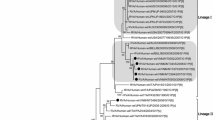Summary.
In an epidemiological study of symptomatic human rotaviruses in Mysore, India during 1993 and 1994, isolates MP409 and MP480 were isolated from two children suffering from severe, acute dehydrating diarrhea. Both isolates exhibited ‘long’ RNA pattern and subgroup I specificity suggesting the likelihood of their animal origin. Both isolates did not react with monoclonal antibodies (MAbs) specific for serotypes G1 to G6 as well as G10. To determine the genetic origin of these isolates, complete nucleotide sequences of genes encoding the outer capsid proteins VP4 and VP7, nonstructural proteins NSP1 and NSP3 and viral enterotoxin protein NSP4 from MP409 and partial sequences of genes from MP480 were determined. Comparison of the 5′ and 3′ terminal sequences of 250 nucleotides revealed complete identity of the gene sequences in both strains suggesting that MP409 and MP480 are two different isolates of a single strain. Comparison of the nucleotide and deduced amino acid sequences of VP4, VP7, NSP1 and NSP3 of MP409 with published sequences of strains belonging to different serotypes revealed that both outer capsid proteins VP4 and VP7 and NSP1 are highly related to the respective proteins from the P6[1], G8 type bovine rotavirus A5 isolated from a calf with diarrhoea in Thailand and that the NSP3 is highly homologous to that of bovine rotaviruses. The NSP4 protein showed greatest sequence identity with NSP4s belonging to the KUN genetic group to which NSP4s from human G2 type strains and bovine rotaviruses belong. MP409 and MP480 likely signify interspecies transmission of P6[1], G8 type strains from cattle to humans and represent the first P6[1] type rotaviruses isolated in humans. These and our previous studies on the asymptomatic neonatal strain I321 are of evolutionary and epidemiological significance in the context of close association of majority of the Indian population with cattle.
Similar content being viewed by others
Author information
Authors and Affiliations
Additional information
Received September 29, 1999 Accepted February 4
Rights and permissions
About this article
Cite this article
Jagannath, M., Vethanayagam, R., Reddy, B. et al. Characterization of human symptomatic rotavirus isolates MP409 and MP480 having ‘long’ RNA electropherotype and subgroup I specificity, highly related to the P6[1],G8 type bovine rotavirus A5, from Mysore, India. Arch. Virol. 145, 1339–1357 (2000). https://doi.org/10.1007/s007050070094
Issue Date:
DOI: https://doi.org/10.1007/s007050070094




